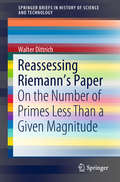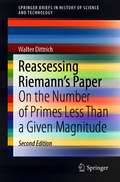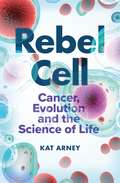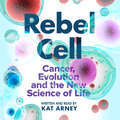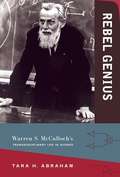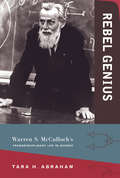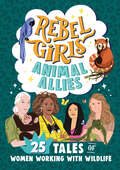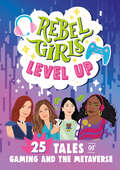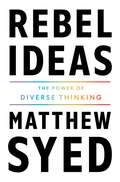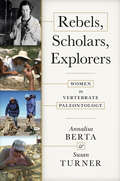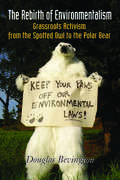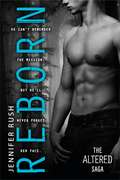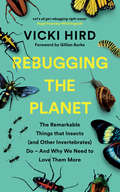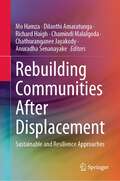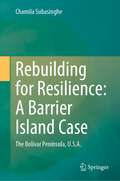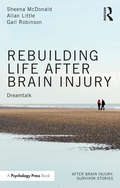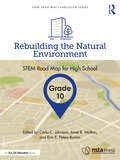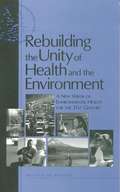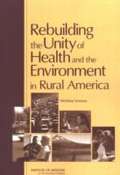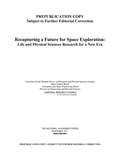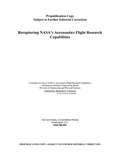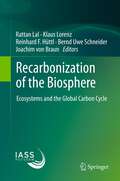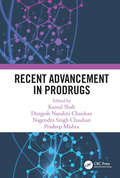- Table View
- List View
Reassessing Riemann's Paper: On The Number Of Primes Less Than A Given Magnitude (Springerbriefs In History Of Science And Technology Ser.)
by Walter DittrichIn this book, the author pays tribute to Bernhard Riemann (1826–1866), mathematician with revolutionary ideas, whose work on the theory of integration, the Fourier transform, the hypergeometric differential equation, etc. contributed immensely to mathematical physics. This book concentrates in particular on Riemann’s only work on prime numbers, including such then new ideas as analytical continuation in the complex plane and the product formula for entire functions. A detailed analysis of the zeros of the Riemann zeta function is presented. The impact of Riemann’s ideas on regularizing infinite values in field theory is also emphasized.
Reassessing Riemann's Paper: On the Number of Primes Less Than a Given Magnitude (SpringerBriefs in History of Science and Technology)
by Walter DittrichIn this book, the author pays tribute to Bernhard Riemann (1826-1866), a mathematician with revolutionary ideas, whose work on the theory of integration, the Fourier transform, the hypergeometric differential equation, etc. contributed immensely to mathematical physics. The text concentrates in particular on Riemann’s only work on prime numbers, including ideas – new at the time – such as analytical continuation into the complex plane and the product formula for entire functions. A detailed analysis of the zeros of the Riemann zeta-function is presented. The impact of Riemann’s ideas on regularizing infinite values in field theory is also emphasized. This revised and enhanced new edition contains three new chapters, two on the application of Riemann’s zeta-function regularization to obtain the partition function of a Bose (Fermi) oscillator and one on the zeta-function regularization in quantum electrodynamics. Appendix A2 has been re-written to make the calculations more transparent. A summary of Euler-Riemann formulae completes the book.
Rebel Cell: Cancer, Evolution and the Science of Life
by Dr Kat Arney'A lively study of the Big C, which makes the case that cancer is the price we pay for our marvellously complicated bodies.' The Times, best books of 2020'This book is packed with big ideas about life. Every chapter has something in it which made me think wow. Having worked in a major cancer charity for many years, Arney writes with genuine in-depth understanding and is a perfect guide.' Daniel M. Davis, author of The Beautiful Cure'Rebel Cell is a bright, engaging read, fizzing with energy and metaphor. Kat Arney is a science writer for all of us - a powerful and talented story teller.' Stephen McGann'Kat's book is Dynamite. A crystal clear reappraisal of the story behind that word we fear to mention.' Dallas Campbell, author of Ad Astra: An Illustrated Guide to Leaving the PlanetCancer has always been with us. It killed our hominid ancestors, the mammals they evolved from and the dinosaurs that trampled the ground before that. Tumours grow in pets, livestock and wild animals. Even tiny jelly-like Hydra - creatures that are little more than a tube full of water - can get cancer. Paradoxically, many of us think of cancer as a contemporary killer, a disease of our own making caused by our modern lifestyles. But that's not true. Although it might be rare in many species, cancer is the enemy lurking within almost every living creature. Why? Because cancer is a bug in the system of life. We get cancer because we can't not get it.Cancer starts when cells revolt, throwing off their molecular shackles, and growing and dividing out of control in a shambolic mockery of normal life. This is why we can't avoid cancer: because the very genes that drive it are essential for life itself. The revolution has raged, on and off, for millions of years. But it was only in the twentieth century that doctors and scientists made any significant progress in understanding and treating cancer, and it's only in the past few decades that we've finally begun to kick the mob's malignant arse. Now the game is changing. Scientists have infiltrated cancer's cellular rebellion and are finally learning its secrets.Geneticist and science writer Kat Arney takes the reader back to the dawn of life on planet earth right up to the present day to get to the heart of what cancer really is and how by better understanding it we might one day overcome it.
Rebel Cell: Cancer, Evolution and the Science of Life
by Dr Kat Arney'A lively study of the Big C, which makes the case that cancer is the price we pay for our marvellously complicated bodies.' The Times, best books of 2020'This book is packed with big ideas about life. Every chapter has something in it which made me think wow. Having worked in a major cancer charity for many years, Arney writes with genuine in-depth understanding and is a perfect guide.' Daniel M. Davis, author of The Beautiful Cure'Rebel Cell is a bright, engaging read, fizzing with energy and metaphor. Kat Arney is a science writer for all of us - a powerful and talented story teller.' Stephen McGann'Kat's book is Dynamite. A crystal clear reappraisal of the story behind that word we fear to mention.' Dallas Campbell, author of Ad Astra: An Illustrated Guide to Leaving the PlanetCancer has always been with us. It killed our hominid ancestors, the mammals they evolved from and the dinosaurs that trampled the ground before that. Tumours grow in pets, livestock and wild animals. Even tiny jelly-like Hydra - creatures that are little more than a tube full of water - can get cancer. Paradoxically, many of us think of cancer as a contemporary killer, a disease of our own making caused by our modern lifestyles. But that's not true. Although it might be rare in many species, cancer is the enemy lurking within almost every living creature. Why? Because cancer is a bug in the system of life. We get cancer because we can't not get it.Cancer starts when cells revolt, throwing off their molecular shackles, and growing and dividing out of control in a shambolic mockery of normal life. This is why we can't avoid cancer: because the very genes that drive it are essential for life itself. The revolution has raged, on and off, for millions of years. But it was only in the twentieth century that doctors and scientists made any significant progress in understanding and treating cancer, and it's only in the past few decades that we've finally begun to kick the mob's malignant arse. Now the game is changing. Scientists have infiltrated cancer's cellular rebellion and are finally learning its secrets.Geneticist and science writer Kat Arney takes the reader back to the dawn of life on planet earth right up to the present day to get to the heart of what cancer really is and how by better understanding it we might one day overcome it.
Rebel Cell: Cancer, Evolution, and the New Science of Life's Oldest Betrayal
by Kat ArneyWhy do we get cancer? Is it our modern diets and unhealthy habits? Chemicals in the environment? An unwelcome genetic inheritance? Or is it just bad luck? The answer is all of these and none of them. We get cancer because we can't avoid it—it's a bug in the system of life itself. Cancer exists in nearly every animal and has afflicted humans as long as our species has walked the earth. In Rebel Cell: Cancer, Evolution, and the New Science of Life's Oldest Betrayal, Kat Arney reveals the secrets of our most formidable medical enemy, most notably the fact that it isn't so much a foreign invader as a double agent: cancer is hardwired into the fundamental processes of life. New evidence shows that this disease is the result of the same evolutionary changes that allowed us to thrive. Evolution helped us outsmart our environment, and it helps cancer outsmart its environment as well—alas, that environment is us. Explaining why "everything we know about cancer is wrong," Arney, a geneticist and award-winning science writer, guides readers with her trademark wit and clarity through the latest research into the cellular mavericks that rebel against the rigid biological "society" of the body and make a leap towards anarchy. We need to be a lot smarter to defeat such a wily foe—smarter even than Darwin himself. In this new world, where we know that every cancer is unique and can evolve its way out of trouble, the old models of treatment have reached their limits. But we are starting to decipher cancer's secret evolutionary playbook, mapping the landscapes in which these rogue cells survive, thrive, or die, and using this knowledge to predict and confound cancer's next move. Rebel Cell is a story about life and death, hope and hubris, nature and nurture. It's about a new way of thinking about what this disease really is and the role it plays in human life. Above all, it's a story about where cancer came from, where it's going, and how we can stop it.
Rebel Genius: Warren S. McCulloch's Transdisciplinary Life in Science
by Tara AbrahamWarren S. McCulloch (1898--1969) adopted many identities in his scientific life -- among them philosopher, poet, neurologist, neurophysiologist, neuropsychiatrist, collaborator, theorist, cybernetician, mentor, engineer. He was, writes Tara Abraham in this account of McCulloch's life and work, "an intellectual showman," and performed this part throughout his career. While McCulloch claimed a common thread in his work was the problem of mind and its relationship to the brain, there was much more to him than that. In Rebel Genius, Abraham uses McCulloch's life as a window on a past scientific age, showing the complex transformations that took place in American brain and mind science in the twentieth century -- particularly those surrounding the cybernetics movement.Abraham describes McCulloch's early work in neuropsychiatry, and his emerging identity as a neurophysiologist. She explores his transformative years at the Illinois Neuropsychiatric Institute and his work with Walter Pitts -- often seen as the first iteration of "artificial intelligence" but here described as stemming from the new tradition of mathematical treatments of biological problems. Abraham argues that McCulloch's dual identities as neuropsychiatrist and cybernetician are inseparable. He used the authority he gained in traditional disciplinary roles as a basis for posing big questions about the brain and mind as a cybernetician. When McCulloch moved to the Research Laboratory of Electronics at MIT, new practices for studying the brain, grounded in mathematics, philosophy, and theoretical modeling, expanded the relevance and ramifications of his work. McCulloch's transdisciplinary legacies anticipated today's multidisciplinary field of cognitive science.
Rebel Genius: Warren S. McCulloch's Transdisciplinary Life in Science (The\mit Press Ser.)
by Tara AbrahamThe life and work of a scientist who spent his career crossing disciplinary boundaries—from experimental neurology to psychiatry to cybernetics to engineering.Warren S. McCulloch (1898–1969) adopted many identities in his scientific life—among them philosopher, poet, neurologist, neurophysiologist, neuropsychiatrist, collaborator, theorist, cybernetician, mentor, engineer. He was, writes Tara Abraham in this account of McCulloch's life and work, “an intellectual showman,” and performed this part throughout his career. While McCulloch claimed a common thread in his work was the problem of mind and its relationship to the brain, there was much more to him than that. In Rebel Genius, Abraham uses McCulloch's life as a window on a past scientific age, showing the complex transformations that took place in American brain and mind science in the twentieth century—particularly those surrounding the cybernetics movement.Abraham describes McCulloch's early work in neuropsychiatry, and his emerging identity as a neurophysiologist. She explores his transformative years at the Illinois Neuropsychiatric Institute and his work with Walter Pitts—often seen as the first iteration of “artificial intelligence” but here described as stemming from the new tradition of mathematical treatments of biological problems. Abraham argues that McCulloch's dual identities as neuropsychiatrist and cybernetician are inseparable. He used the authority he gained in traditional disciplinary roles as a basis for posing big questions about the brain and mind as a cybernetician. When McCulloch moved to the Research Laboratory of Electronics at MIT, new practices for studying the brain, grounded in mathematics, philosophy, and theoretical modeling, expanded the relevance and ramifications of his work. McCulloch's transdisciplinary legacies anticipated today's multidisciplinary field of cognitive science.
Rebel Girls Animal Allies: 25 Tales of Women Working with Wildlife (Rebel Girls Minis)
by Rebel Girls Lucy KingTRUE STORIES OF ANIMAL ADVOCATESMeet 25 brave, compassionate scientists, veterinarians, activists, and others who fight for animal rights and conservation. Animal Allies takes readers all around the world—to the tops of trees and the bottom of oceans, deep into the jungle and high into the mountains.Swim with the sharks alongside Eugenie Clark, build bat houses with Amanda Lear, nurse a baby hippo to health with Christina Gorsuch, and protect endangered seahorses with Amanda Vincent and Heather Koldewey.With a foreword by zoologist Lucy King and activities curated by conservationist Bindi Irwin, this book is sure to inspire animal lovers everywhere. Plus, scannable codes let you listen to longer stories on the Rebel Girls App!
Rebel Girls Level Up: 25 Tales of Gaming and the Metaverse (Rebel Girls Minis)
by Rebel GirlsTRUE STORIES OF CREATORS AND COMMUNITY!Meet 25 inspiring women in the world of gaming and the metaverse. Read about how they&’ve created innovative technology, designed the video games you play, and broken barriers whenever their industry put up walls.Dive into gamer communities with popular streamers like Imane Anys, better known as Pokimane. Learn to lead with Aya Kyogoku, who directed several Animal Crossing games. Design digital clothing with Roblox creators like cSapphire. And compete in the wild world of esports with pro gamers Sasha Hostyn and Sylvia Gathoni.This book pairs inspiring, easy-to-read text with colorful full-page portraits created by female and nonbinary artists from all around the world. Plus, scannable codes let you listen to longer stories on the Rebel Girls app!
Rebel Ideas: The Power of Diverse Thinking
by Matthew SyedIdeas are everywhere, but those with the greatest problem-solving, business-transforming, and life-changing potential are often hard to identify. Even when we recognize good ideas, applying them to everyday obstacles—whether in the workplace, our homes, or our civic institutions—can seem insurmountable. According to Matthew Syed, it doesn't have to be this way. In Rebel Ideas, Syed argues that our brainpower as individuals isn't enough. To tackle problems from climate change to economic decline, we'll need to employ the power of "cognitive diversity." Drawing on psychology, genetics, and beyond, Syed uses real-world scenarios including the failings of the CIA before 9/11 and a communication disaster at the peak of Mount Everest to introduce us to the true power of thinking differently. Rebel Ideas will strengthen any kind of team, while including advice on how, as individuals, we can embrace the potential of an "outsider mind-set" as our greatest asset. Matthew Syed is the Sunday Times bestselling author of Black Box Thinking, Bounce, and The Greatest. He writes an award-winning newspaper column in The Times and is the host of the hugely successful BBC podcast Flintoff, Savage and the Ping Pong Guy.
Rebels, Scholars, Explorers: Women in Vertebrate Paleontology
by Annalisa Berta Susan TurnerUnearthing the amazing hidden stories of women who changed paleontology forever.For centuries, women have played key roles in defining and developing the field of vertebrate paleontology. Yet very little is known about these important paleontologists, and the true impacts of their contributions have remained obscure. In Rebels, Scholars, Explorers, Annalisa Berta and Susan Turner celebrate the history of women "bone hunters," delving into their fascinating lives and work. At the same time, they explore how the discipline has shaped our understanding of the history of life on Earth.Berta and Turner begin by presenting readers with a review of the emergence of vertebrate paleontology as a science, emphasizing the contributions of women to research topics and employment. This is followed by brief biographical sketches and explanations of early discoveries by women around the world over the past 200 years, including those who who held roles as researchers, educators, curators, artists, and preparators. Forging new territory, Berta and Turner highlight the barriers and challenges faced by women paleontologists, describing how some managed to overcome those obstacles in order to build careers in the field. Finally, drawing on interviews with a diverse group of contemporary paleontologists, who share their experiences and offer recommendations to aspiring fossil hunters, they provide perspectives on what work still needs to be done in order to ensure that women's contributions to the field are encouraged and celebrated. Uncovering and relating lost stories about the pivotal contributions of women in vertebrate paleontology doesn't just make for enthralling storytelling, but also helps ensure a richer and more diverse future for this vibrant field. Illuminating the discoveries, collections, and studies of fossil vertebrates conducted by women in vertebrate paleontology, Rebels, Scholars, Explorers will be on every paleontologist's most-wanted list and should find a broader audience in the burgeoning sector of readers from all backgrounds eager to learn about women in the sciences.
The Rebirth of Environmentalism: Grassroots Activism from the Spotted Owl to the Polar Bear
by Douglas BevingtonOver the past two decades, a select group of small but highly effective grassroots organizations have achieved remarkable success in protecting endangered species and forests in the United States. The Rebirth of Environmentalism tells for the first time the story of these grassroots biodiversity groups. Author Douglas Bevington offers engaging case studies of three of the most influential biodiversity protection campaigns--the Headwaters Forest campaign, the "zero cut" campaign on national forests, and the endangered species litigation campaign exemplified by the Center for Biological Diversity--providing the reader with an in-depth understanding of the experience of being involved in grassroots activism.Based on first-person interviews with key activists in these campaigns, the author explores the role of tactics, strategy, funding, organization, movement culture, and political conditions in shaping the influence of the groups. He also examines the challenging relationship between radicals and moderate groups within the environmental movement, and addresses how grassroots organizations were able to overcome constraints that had limited the advocacy of other environmental organizations.Filled with inspiring stories of activists, groups, and campaigns that most readers will not have encountered before, The Rebirth of Environmentalism explores how grassroots biodiversity groups have had such a big impact despite their scant resources, and presents valuable lessons that can help the environmental movement as a whole--as well as other social movements--become more effective.
Reborn (Altered #3)
by Jennifer RushThe Branch is in shambles, but Anna, Sam, Cas, and Nick can't rest easy. Remnants of the organization lurk unseen and the flashbacks to their old lives are only getting stronger--especially Nick's.Following scattered memories and clues from his Branch file, Nick sets off alone in search of answers and in search of the girl who haunts his dreams. But the sleepy town where she lives in full of secrets and Nick soon learns that uncovering their shared past may have deadly consequences.
Rebugging the Planet: The Remarkable Things that Insects (and Other Invertebrates) Do – And Why We Need to Love Them More
by Vicki Hird"This is a lovely little book that could and should have a big impact...Let’s all get rebugging right away!"—Hugh Fearnley-Whittingstall Meet the intelligent insects, marvelous minibeasts, and inspirational invertebrates that help shape our planet—and discover how you can help them help us by rebugging your attitude today! Remember when there were bugs on your windshield? Ever wonder where they went? We need to act now if we are to help the insects survive. Robin Wall Kimmerer, David Attenborough, and Elizabeth Kolbert are but a few voices championing the rewilding of our world. Rebugging the Planet explains how we are headed toward “insectageddon” with a rate of insect extinction eight times faster than that of mammals or birds, and gives us crucial information to help all those essential creepy-crawlies flourish once more. Author Vicki Hird passionately demonstrates how insects and invertebrates are the cornerstone of our global ecosystem. They pollinate plants, feed birds, support and defend our food crops, and clean our water systems. They are also beautiful, inventive, and economically invaluable—bees, for example, contribute an estimated $235 to $577 billion to the US economy annually, according to Forbes. Rebugging the Planet shows us small changes we can make to have a big impact on our littlest allies: Learn how to rewild parks, schools, sidewalks, roadsides, and other green spaces. Leave your garden to grow a little wild and plant weedkiller-free, wildlife-friendly plants. Take your kids on a minibeast treasure hunt and learn how to build bug palaces. Make bug-friendly choices with your food and support good farming practices Begin to understand how reducing inequality and poverty will help nature and wildlife too—it’s all connected. So do your part and start rebugging today! The bees, ants, earthworms, butterflies, beetles, grasshoppers, ladybugs, snails, and slugs will thank you—and our planet will thank you too.
Rebuilding Communities After Displacement: Sustainable and Resilience Approaches
by Mo Hamza Dilanthi Amaratunga Richard Haigh Chamindi Malalgoda Chathuranganee Jayakody Anuradha SenanayakeThis book presents a collection of double-blind peer reviewed papers under the scope of sustainable and resilient approaches for rebuilding displaced and host communities. Forced displacement is a major development challenge, not only a humanitarian concern. A surge in violent conflict, as well as increasing levels of disaster risk and environmental degradation driven by climate change, has forced people to leave or flee their homes – both internally displaced as well as refugees. The rate of forced displacement befalling in different countries all over the world today is phenomenal, with an increasingly higher rate of the population being affected on daily basis than ever. These displacement situations are becoming increasingly protracted, many lasting over 5 years. Therefore, there is a need to develop more sustainable and resilient approaches to rebuild these displaced communities ensuring the long-term satisfaction of communities and enhancing the social cohesion between the displaced and host communities. Accordingly, chapters are arranged around five main themes of rebuilding communities after displacement.Response management for displaced communitiesThe Built environment in resettlement planningGovernance of displacementSocio-Economic interventions for sustainable resettlement
Rebuilding for Resilience: The Bolivar Peninsula, U.S.A.
by Chamila SubasingheRecurring extreme events of nature challenge disaster-prone settlements in complex ways. Devastating property damages are one of the tests of survival for such settlements in both economic and social terms. It also provides unique opportunities to rethink the environment cleared by massive natural disasters. However, rebuilding for long-term resiliency is one of the least investigated areas, particularly when employing tacit knowledge in the sustainable recovery process. This book builds a discursive field around the post-disaster rebuilding of Bolivar Peninsula aftermath Hurricane Ike to demonstrate reciprocity between disaster absorptive ecological formations such as barrier islands and their exploitative human occupation. In the process, it investigates the nexus between connectivity among open space networks to various levels of surge damage among Bolivar spontaneous settlements. Beyond scientific analyses, the Hurricane Ike study triangulates syntactical methods with structured observations and statistical analyses to offer a holistic reporting model for emerging scholars and independent investigators, which one may find quite absent in the mainstream disaster studies and journalism.
Rebuilding Life after Brain Injury: Dreamtalk (After Brain Injury: Survivor Stories)
by Sheena McDonald Allan Little Gail RobinsonRebuilding Life after Brain Injury: Dreamtalk tells the survival story of Sheena McDonald, who in 1999 was hit by a police van and suffered a very severe brain injury. Sheena’s story is told from her own, personal standpoint and also from two further unique and invaluable perspectives. Allan Little, a BBC journalist and now Sheena’s husband, describes both the physical and mental impact of the injury on himself and on Sheena. Gail Robinson, Sheena’s neuropsychological rehabilitation specialist, provides professional commentaries on Sheena’s condition, assessment and recovery process. The word Dreamtalk, created by Allan to describe Sheena’s once "hallucinogenic state", sets the tone for this book. It humanises and contextualises the impact of brain injury, providing support and encouragement for patients, professionals and families. It presents exclusive insights into each stage of recovery, spanning coma, altered consciousness, post-traumatic amnesia and rehabilitation; all showing how she has defied conventional clinical expectations and made an exceptional recovery. This book is valuable reading to those who have suffered a brain injury and also to professionals such as neurologists, neuropsychologists, physiotherapists, occupational therapists and speech therapists working in the field.
Rebuilding the Natural Environment, Grade 10: STEM Road Map for High School (STEM Road Map Curriculum Series)
by Carla C. Johnson Janet B. Walton Erin E. Peters-BurtonWhat if you could challenge your tenth graders to think about how innovation can make the world a better place for humans, while finding ways to sustain progress and conserve resources? With this volume in the STEM Road Map Curriculum Series, you can! Rebuilding the Natural Environment outlines a journey that will steer your students toward authentic problem solving while grounding them in integrated STEM disciplines. Like the other volumes in the series, this book is designed to meet the growing need to infuse real-world learning into K–12 classrooms. This interdisciplinary, four-lesson module uses project- and problem-based learning to help students connect their existing knowledge about energy production and its effects on the natural environment to create innovations in renewable sources of energy based on research evidence. Working in teams, students will design an innovative way to meet society’s energy needs and develop a pitch to market their innovation, focusing on how the innovation will optimize human experiences while being mindful of the natural environment. To support this goal, students will do the following: • Understand several forms of renewable, sustainable energy sources. • Apply their understanding of how alternators are used to generate electricity in lab experiments, as well as explain how tools such as windmills and dams are used to operate them. • Describe how electricity is generated in photovoltaic cells. • Calculate the amount of electricity consumed by several household items and consider this consumption when determining the average monthly energy consumption of households around the world in comparison to U.S. households. • Understand how fossil fuels have been used in the production of electricity and the impact they have had on the world’s economy, humans’ quality of life, and the earth. • Identify several hindrances to the creation of new energy sources as well as ideas to counter them. • List several factors that can be used to motivate people from all walks of life to use renewable and sustainable energies. • Create a fictional company that uses renewable energies. The STEM Road Map Curriculum Series is anchored in the Next Generation Science Standards, the Common Core State Standards, and the Framework for 21st Century Learning. In-depth and flexible, Rebuilding the Natural Environment can be used as a whole unit or in part to meet the needs of districts, schools, and teachers who are charting a course toward an integrated STEM approach.
Rebuilding the Unity of Health and the Environment: A NEW VISION OF ENVIRONMENTAL HEALTH FOR THE 21ST CENTURY
by Kathi Hanna Christine CoussensInformation on Rebuilding the Unity of Health and the Environment
Rebuilding the Unity of Health and the Environment: Workshop Summary
by Institute of Medicine of the National AcademiesA summary on Rebuilding the Unity of Health and the Environment: The Greater Houston Metropolitan Area
Rebuilding the Unity of Health and the Environment in Rural America: Workshop Summary
by Institute of Medicine of the National AcademiesThe National Academies Press (NAP)--publisher for the National Academies--publishes more than 200 books a year offering the most authoritative views, definitive information, and groundbreaking recommendations on a wide range of topics in science, engineering, and health. Our books are unique in that they are authored by the nation's leading experts in every scientific field.
Recapturing a Future for Space Exploration: Life and Physical Sciences Research for a New Era
by Committee for the Decadal Survey on Biological Physical Sciences in SpaceMore than four decades have passed since a human first set foot on the Moon. Great strides have been made in our understanding of what is required to support an enduring human presence in space, as evidenced by progressively more advanced orbiting human outposts, culminating in the current International Space Station (ISS). However, of the more than 500 humans who have so far ventured into space, most have gone only as far as near-Earth orbit, and none have traveled beyond the orbit of the Moon. Achieving humans' further progress into the solar system had proved far more difficult than imagined in the heady days of the Apollo missions, but the potential rewards remain substantial. During its more than 50-year history, NASA's success in human space exploration has depended on the agency's ability to effectively address a wide range of biomedical, engineering, physical science, and related obstacles--an achievement made possible by NASA's strong and productive commitments to life and physical sciences research for human space exploration, and by its use of human space exploration infrastructures for scientific discovery. The Committee for the Decadal Survey of Biological and Physical Sciences acknowledges the many achievements of NASA, which are all the more remarkable given budgetary challenges and changing directions within the agency. In the past decade, however, a consequence of those challenges has been a life and physical sciences research program that was dramatically reduced in both scale and scope, with the result that the agency is poorly positioned to take full advantage of the scientific opportunities offered by the now fully equipped and staffed ISS laboratory, or to effectively pursue the scientific research needed to support the development of advanced human exploration capabilities. Although its review has left it deeply concerned about the current state of NASA's life and physical sciences research, the Committee for the Decadal Survey on Biological and Physical Sciences in Space is nevertheless convinced that a focused science and engineering program can achieve successes that will bring the space community, the U. S. public, and policymakers to an understanding that we are ready for the next significant phase of human space exploration. The goal of this report is to lay out steps and develop a forward-looking portfolio of research that will provide the basis for recapturing the excitement and value of human spaceflight--thereby enabling the U. S. space program to deliver on new exploration initiatives that serve the nation, excite the public, and place the United States again at the forefront of space exploration for the global good.
Recapturing NASA's Aeronautics Flight Research Capabilities
by Committee to Assess NASA's Aeronautics Flight Research CapabilitiesIn the five decades since NASA was created, the agency has sustained its legacy from the National Advisory Committee on Aeronautics (NACA) in playing a major role in U.S. aeronautics research and has contributed substantially to United States preeminence in civil and military aviation. This preeminence has contributed significantly to the overall economy and balance of trade of the United States through the sales of aircraft throughout the world. NASA's contributions have included advanced flight control systems, de-icing devices, thrust-vectoring systems, wing fuselage drag reduction configurations, aircraft noise reduction, advanced transonic airfoil and winglet designs, and flight systems. Each of these contributions was successfully demonstrated through NASA flight research programs. Equally important, the aircraft industry would not have adopted these and similar advances without NASA flight demonstration on full-scale aircraft flying in an environment identical to that which the aircraft are to operate-in other words, flight research. Flight research is a tool, not a conclusion. It often informs simulation and modeling and wind tunnel testing. Aeronautics research does not follow a linear path from simulation to wind tunnels to flying an aircraft. The loss of flight research capabilities at NASA has therefore hindered the agency's ability to make progress throughout its aeronautics program by removing a primary tool for research. Recapturing NASA's Aeronautics Flight Research Capabilities discusses the motivation for NASA to pursue flight research, addressing the aspects of the committee's task such as identifying the challenges where research program success can be achieved most effectively through flight research. The report contains three case studies chosen to illustrate the state of NASA ARMD. These include the ERA program and the Fundamental Research Program's hypersonics and supersonics projects. Following these case studies, the report describes issues with the NASA ARMD organization and management and offers solutions. In addition, the chapter discusses current impediments to progress, including demonstrating relevancy to stakeholders, leadership, and the lack of focus relative to available resources. Recapturing NASA's Aeronautics Flight Research Capabilities concludes that the type and sophistication of flight research currently being conducted by NASA today is relatively low and that the agency's overall progress in aeronautics is severely constrained by its inability to actually advance its research projects to the flight research stage, a step that is vital to bridging the confidence gap. NASA has spent much effort protecting existing research projects conducted at low levels, but it has not been able to pursue most of these projects to the point where they actually produce anything useful. Without the ability to actually take flight, NASA's aeronautics research cannot progress, cannot make new discoveries, and cannot contribute to U.S. aerospace preeminence. <P> Advisory: Bookshare has learned that this book offers only partial accessibility. We have kept it in the collection because it is useful for some of our members. To explore further access options with us, please contact us through the Book Quality link on the right sidebar. Benetech is actively working on projects to improve accessibility issues such as these.
Recarbonization of the Biosphere
by Joachim Von Braun Rattan Lal Bernd Uwe Schneider Klaus Lorenz Reinhard F. HüttlHuman activities are significantly modifying the natural global carbon (C) cycles, and concomitantly influence climate, ecosystems, and state and function of the Earth system. Ever increasing amounts of carbon dioxide (CO2) are added to the atmosphere by fossil fuel combustion but the biosphere is a potential C sink. Thus, a comprehensive understanding of C cycling in the biosphere is crucial for identifying and managing biospheric C sinks. Ecosystems with large C stocks which must be protected and sustainably managed are wetlands, peatlands, tropical rainforests, tropical savannas, grasslands, degraded/desertified lands, agricultural lands, and urban lands. However, land-based sinks require long-term management and a protection strategy because C stocks grow with a progressive improvement in ecosystem health.
Recent Advancement in Prodrugs
by Kamal Shah Durgesh Nandini Chauhan Nagendra Singh Chauhan Pradeep MishraRecent Advancement in Prodrugs Drugs used as medicines have many limitations like low chemical stability, aqueous solubility, or oral absorption/bioavailability, rapid presystemic metabolism, toxicity, inadequate site specificity, or poor patient acceptance/compliance (unwanted adverse effects, unacceptable taste or odor, irritation or pain). Prodrugs design is an approach to overcome these limitations. Key features Covers recent advancements in development of prodrugs Presents balanced synthesis and applications of prodrug chemistry Discusses broad spectrum of prodrug categories and outlines industrial applications Reviews prodrugs in cancer nanomedicine, its therapy and treatment Elucidates mathematical models to study the kinetics of prodrugs This book covers recent advances in the design of prodrugs. It contains all the significant recent examples of prodrug chemistry developments and will aid academics and researchers seeking to generate new projects in the field.
